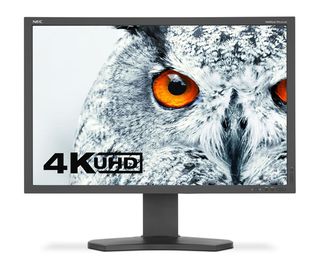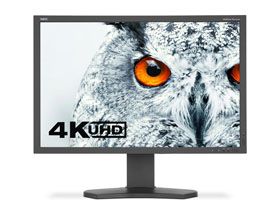Early Verdict
With a host of calibration features that all work with precision; administrative options that make it easy to integrate into an enterprise; fantastic build quality and a four-year warranty, it’s hard not to recommend the NEC PA322UHD regardless of its price. The Dell UP3214Q is still a great choice but if you want the absolute best in accuracy and adjustability, look no further.
Pros
- +
Grayscale
- +
Gamma
- +
Color accuracy
- +
Contrast
- +
Calibration options
- +
Build Quality, Warranty
Cons
- -
Price
- -
Default settings reduce color accuracy
Why you can trust Tom's Hardware
Introduction
We’ve been reviewing Ultra HD monitors from every major manufacturer for over a year. The first-gen models, all of which are still for sale, were based on IGZO technology (similar to IPS, but with a potentially more responsive pixel structure). Those screens from Dell, Sharp and Asus originally sold for $3000 and up. They've since dropped to saner prices, though. In fact, the Dell UP3214Q - still a great monitor by today’s standards - can be had for well under $2000.

Today we’re checking out the latest IGZO-based panel on the market, NEC’s PA322UHD. It gets us back up to that $3000 level. But compared to the others, the PA322UHD offers even better performance and build quality. It's a great addition to the pro-oriented PA line of precision monitors. With a self-adjusting mode that doesn’t require a computer and a wide-gamut option, professionals shopping for a jumbo Ultra HD screen may have a new top-end model to lust over.
Specifications
The PA322UHD is indeed based on a Sharp IGZO panel - in this case the newest wide-gamut version sporting a white LED backlight. Its main feature is a native 10-bit color depth, to which NEC adds a 14-bit 3D look-up table. This means you can use it with a native 10-bit signal and add even more color choices by means of your graphics software to create a larger palette. The gamut doesn’t go beyond Adobe RGB; you simply have more shades of each color available. And if sRGB is all you need, that gamut is included too.
NEC’s PA line is all about creating professional tools. Given the results from our benchmark suite, we’d take that a step further and call this screen a precision instrument. Calibration isn’t necessary thanks to a factory-certified process that renders all color and white point errors below one DeltaE. That’s well below the visible threshold of three DeltaE. And yes, our measurements confirm the factory’s to within a very tight tolerance.
For those who like to tweak, NEC still provides a huge array of options in the OSD. There is a full color management system capable of adjusting hue, saturation and luminance for each color. Or, you can use the x and y coordinates to dial in color points precisely. Coupled with dead-perfect gamma presets and a high-resolution white balance adjustment, you only need a meter and the appropriate software to achieve fantastic results.
If you don’t have the means, NEC offers SpectraView software, which works with a variety of instruments to set the PA322UHD to whatever standard you desire. And for those looking for a quick occasional touch-up, again, the monitor can calibrate itself without the use of a computer.
NEC's price is high, but so is the comprehensiveness of this screen's feature set. Is it a worthy addition to the Ultra HD monitor ranks? Let’s take a look.
MORE: Best Computer MonitorsMORE: Display Testing Explained: How We Test Monitors And TVs
MORE: All Monitor Articles
MORE: Latest Monitor NewsMORE: Displays in the Forums

Christian Eberle is a Contributing Editor for Tom's Hardware US. He's a veteran reviewer of A/V equipment, specializing in monitors. Christian began his obsession with tech when he built his first PC in 1991, a 286 running DOS 3.0 at a blazing 12MHz. In 2006, he undertook training from the Imaging Science Foundation in video calibration and testing and thus started a passion for precise imaging that persists to this day. He is also a professional musician with a degree from the New England Conservatory as a classical bassoonist which he used to good effect as a performer with the West Point Army Band from 1987 to 2013. He enjoys watching movies and listening to high-end audio in his custom-built home theater and can be seen riding trails near his home on a race-ready ICE VTX recumbent trike. Christian enjoys the endless summer in Florida where he lives with his wife and Chihuahua and plays with orchestras around the state.
-
Nuckles_56 I was wondering and couldn't see anywhere but what HDMI and display port versions is the panel using?Reply -
MonsterCookie In this bad economy, where especially the "first wirld" countries are affected who kould pay for such toys, asking 3000$ (nowadays the same as 3000Euros) is almost ludacris. That is the price for a decent used car.Reply
Please just make first standard 30-inch 256x1600 screens available for an affordable price, and only after that is done, hope to sell these gems on the market.
No offence, but here in Europe things are running so bad, that even design companies (where color accuracy is important are outsourcing), and they definitely cannot afford to splash 3000Euros of a darn computer screen.
Not even talking about the private sector. -
MonsterCookie I know that that there will be hundreds of people commenting that for them this monitor is cheap.Reply
Well, lucky YOU!
In socialist (nowadays becoming almost communist) countries like within the EU, where the state steals 48% of our salary as tax, we do *NOT* make six figures to pay for these things. Period.
Btw, Tom's. Why on earth is there no Edit button?
Just noticed that I made lots of typos in my first post because I was so angry at the price... -
beebbeeb The other top dog is Eizo, and the proper comparator is obviously Eizo ColourEdge series. Hope that Tom's Hardware will do a review of Eizo soon.Reply -
Tanquen This is kind of out there. My 5 year old Dell U3011 (16:10, 2560x1600) was $950 when I got 2 of them, has 10-bit color and works fine. Going up to edge lit LED at 3840x2160 (16:9 Yuck!) , 5 years later for $3000 is too much. For $2000 it should be 4096x2160 or 5120x3200 (16:10) and have a better multi zone LED back light and have a better response time.Reply
TVs are bigger and do it for much less.
Eizo and LG have 30"-ish 4096x2160 displays for less and what is with the bezels still being so huge. Look how deep this this is, why is the bezel so big. Again, bigger TVs have small bezels and people actually want to put two or three PC monitors next to each other. -
Shankovich Some comments aren't realizing this is a professional oriented monitor. Targeted to artists, video editors, probably some types of engineers. Not for gaming guys (though it could game quite well it seems)Reply -
mechanus If I had $3000 I'd start a business like selling stuff on amazon instead of spend it on a lot tiny light bulbs under a glass sheet.Reply -
mechanus If I had $3000 I'd start a business like selling stuff on amazon instead of spend it on a lot tiny light bulbs under a glass sheet.Reply

